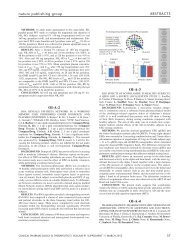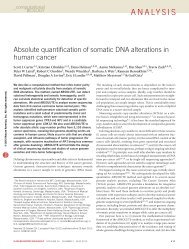open access: Nature Reviews: Key Advances in Medicine
open access: Nature Reviews: Key Advances in Medicine
open access: Nature Reviews: Key Advances in Medicine
Create successful ePaper yourself
Turn your PDF publications into a flip-book with our unique Google optimized e-Paper software.
MOVEMENT DISORDERS IN 2011<br />
Translat<strong>in</strong>g new research f<strong>in</strong>d<strong>in</strong>gs<br />
<strong>in</strong>to cl<strong>in</strong>ical practice<br />
Christ<strong>in</strong>e Kle<strong>in</strong> and Dimitri Kra<strong>in</strong>c<br />
The discovery of mutations that contribute to movement disorders<br />
has facilitated the identification of converg<strong>in</strong>g pathways and novel<br />
therapeutic targets. Successful translation of these research f<strong>in</strong>d<strong>in</strong>gs <strong>in</strong>to<br />
cl<strong>in</strong>ical practice will require identification of early markers of disease<br />
progression, and recent research <strong>in</strong>dicates that progress is be<strong>in</strong>g made <strong>in</strong><br />
this area.<br />
Kle<strong>in</strong>, C. & Kra<strong>in</strong>c, D. Nat. Rev. Neurol. 8, 65–66 (2012); published onl<strong>in</strong>e 20 December 2011;<br />
doi:10.1038/nrneurol.2011.212<br />
The prevalence of Park<strong>in</strong>son disease (PD)<br />
and other neurodegenerative disorders<br />
is rapidly <strong>in</strong>creas<strong>in</strong>g worldwide and is<br />
expected to double by 2030, 1 yet not a s<strong>in</strong>gle<br />
disease-modify<strong>in</strong>g treatment exists for this<br />
disorder. Thus, translation of research f<strong>in</strong>d<strong>in</strong>gs<br />
<strong>in</strong>to all aspects of cl<strong>in</strong>ical practice—that<br />
is, diagnosis, monitor<strong>in</strong>g and treatment—<strong>in</strong><br />
movement disorders is a high priority. One<br />
of the major challenges of translational<br />
research <strong>in</strong> movement disorders has been<br />
the apparent lack of specific molecular targets<br />
as platforms for drug development.<br />
How ever, as highlighted by a number of<br />
important studies published <strong>in</strong> 2011, the<br />
emergence of various forms of genetic PD<br />
has offered us an excit<strong>in</strong>g opportunity to<br />
identify such targets.<br />
‘‘ Identification and monitor<strong>in</strong>g<br />
of the earliest disease stages<br />
… is of great importance<br />
Most mutations that have been l<strong>in</strong>ked<br />
to PD and related synucle<strong>in</strong>opathies seem to<br />
converge on lysosomal and mito chondrial<br />
pathways, suggest<strong>in</strong>g that disruptions of<br />
these pathways have key roles <strong>in</strong> disease<br />
pathogenesis. The importance of lysosomal<br />
function <strong>in</strong> synucle<strong>in</strong>opathies was highlighted<br />
<strong>in</strong> a recent study by Mazzulli and<br />
colleagues that exam<strong>in</strong>ed Gaucher disease,<br />
a rare lysosomal storage disorder caused by<br />
mutations <strong>in</strong> the glucocerebro sidase (GBA1)<br />
gene. 2 ’’<br />
Patients with Gaucher disease and<br />
their relatives have an <strong>in</strong>creased <strong>in</strong>cidence of<br />
PD, and patients with idiopathic PD have an<br />
elevated prevalence of mutations <strong>in</strong> GBA1.<br />
Interest<strong>in</strong>gly, accumulated α-synucle<strong>in</strong><br />
<strong>in</strong>terferes with traffick<strong>in</strong>g of glucocerebrosidase<br />
from the endo plasmic reticulum<br />
to the Golgi apparatus, which <strong>in</strong> turn leads to<br />
decreased glucocerebrosidase activity and<br />
more accumulation of α-synucle<strong>in</strong>. The<br />
bidirectional effects of α-synucle<strong>in</strong> and<br />
glucocerebro sidase form a positive feedback<br />
loop that, beyond a certa<strong>in</strong> threshold, leads<br />
to self-propagat<strong>in</strong>g disease.<br />
The f<strong>in</strong>d<strong>in</strong>gs suggest that this molecular<br />
pathway applies also to patients with idiopathic<br />
PD or other synucle<strong>in</strong>opathies who<br />
carry a normal GBA1 gene. The results <strong>in</strong>dicate<br />
that therapeutic target<strong>in</strong>g of mutated<br />
or normal gluco cerebrosidase to lysosomes<br />
would be expected to prevent or dim<strong>in</strong>ish<br />
the formation of toxic α-synucle<strong>in</strong> oligomers<br />
and break the vicious circle of α-synucle<strong>in</strong><br />
aggregation and toxicity. Importantly, these<br />
f<strong>in</strong>d<strong>in</strong>gs were confirmed <strong>in</strong> human neurons<br />
derived from <strong>in</strong>duced pluripotent stem<br />
cells, 2 which represent a major advance for<br />
the model<strong>in</strong>g of neurodegenerative and<br />
other diseases. 3<br />
The importance of lysosomal pathways<br />
<strong>in</strong> PD was further highlighted <strong>in</strong> two backto-back<br />
publications by Vilar<strong>in</strong>o-Guell<br />
et al. 4 and Zimprich et al. 5 that described<br />
a dom<strong>in</strong>antly <strong>in</strong>herited mutation <strong>in</strong> the<br />
vacuo lar prote<strong>in</strong> sort<strong>in</strong>g 35 (VPS35) gene as<br />
a novel, albeit rare, cause of late-onset PD.<br />
As a component of the retromer complex,<br />
VPS35 sorts cargo from endosomes back to<br />
the trans-Golgi network, and disruptions <strong>in</strong><br />
this pathway are expected to affect lysosomal<br />
function. Intrigu<strong>in</strong>gly, both studies detected<br />
the same VPS35 mutation (Asp620Asn), <strong>in</strong><br />
Swiss and Austrian k<strong>in</strong>dreds, respectively,<br />
and the same mutation was also recently<br />
identified <strong>in</strong> a German pedigree. 6 When the<br />
analyses were extended to additional families<br />
from various ethnic backgrounds, both<br />
<strong>in</strong>itial studies confirmed the Asp620Asn<br />
mutation <strong>in</strong> <strong>in</strong>dependent cases and found<br />
two additional variants <strong>in</strong> the VPS35 gene. 4,5<br />
On the basis of these studies, and previous<br />
data show<strong>in</strong>g that the retromer regulates<br />
endosomal sort<strong>in</strong>g of amyloid precursor<br />
NEUROLOGY<br />
prote<strong>in</strong> <strong>in</strong> models of Alzheimer disease, it<br />
will be <strong>in</strong>terest<strong>in</strong>g to exam<strong>in</strong>e the role of<br />
VPS35 <strong>in</strong> the pathogenesis of PD. These<br />
studies also highlight the importance of<br />
next-generation sequenc<strong>in</strong>g for the discovery<br />
of genetic factors—many of which<br />
are likely to be rare—that cause or contribute<br />
to complex movement disorders. 7<br />
Besides improv<strong>in</strong>g our understand<strong>in</strong>g of<br />
disease biology, the identification of monogenic<br />
forms of movement disorders has<br />
<strong>open</strong>ed up a new w<strong>in</strong>dow <strong>in</strong>to the pre motor<br />
stage of neurodegenerative conditions—the<br />
historical frontrunner be<strong>in</strong>g Hunt<strong>in</strong>gton<br />
disease—whereby <strong>in</strong>dividuals at risk can<br />
be studied prospectively. Identification<br />
and monitor<strong>in</strong>g of the earliest disease<br />
stages, dur<strong>in</strong>g which treatment and neuroprotection<br />
are expected to be most effective,<br />
is of great importance. Selection of carefully<br />
characterized and homogeneous cohorts of<br />
patients or at-risk <strong>in</strong>dividuals will be vital<br />
for the development of new drugs for PD<br />
and other movement disorders. This task<br />
would be greatly facilitated by employ<strong>in</strong>g<br />
adequate biomarkers for diagnosis of the<br />
disease, and for monitor<strong>in</strong>g its course and<br />
potential effects of treatment.<br />
In a study published <strong>in</strong> PLoS ONE,<br />
Yanamandra et al. hypothesized that autoimmune<br />
reactivity towards specific prote<strong>in</strong>s<br />
and self-assembled complexes that<br />
are <strong>in</strong>volved <strong>in</strong> disease pathology may<br />
serve as sensitive biomarkers of neurodegeneration.<br />
8 The researchers measured<br />
<strong>Key</strong> advances<br />
■ α‑Synucle<strong>in</strong> and glucocerebrosidase<br />
form a bidirectional pathogenic loop,<br />
provid<strong>in</strong>g an important pathophysiological<br />
mechanism <strong>in</strong> the development of<br />
Park<strong>in</strong>son disease (PD) 2<br />
■ Next‑generation sequenc<strong>in</strong>g has led to<br />
the discovery of a new gene (VPS35)<br />
associated with late‑onset PD; this<br />
f<strong>in</strong>d<strong>in</strong>g implicates retrograde transport <strong>in</strong><br />
PD pathogenesis 4,5<br />
■ α‑Synucle<strong>in</strong>‑reactive antibodies may<br />
serve as a new biomarker for PD,<br />
especially <strong>in</strong> its early phase 8<br />
■ Induced pluripotent stem cell‑derived<br />
neurons represent a patient‑specific<br />
cellular model with great potential for<br />
the study of disease biology 2<br />
■ The first double‑bl<strong>in</strong>d, sham‑surgery‑<br />
controlled, randomized trial of viral gene<br />
transfer of glutamic acid decarboxylase<br />
resulted <strong>in</strong> improved motor scores <strong>in</strong><br />
patients with PD, and the treatment<br />
was not associated with severe<br />
adverse events 9<br />
KEY ADVANCES IN MEDICINE JANUARY 2012 | S57








